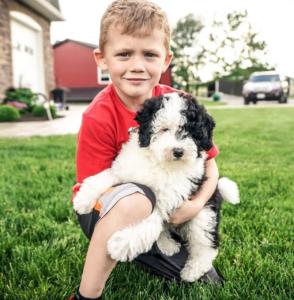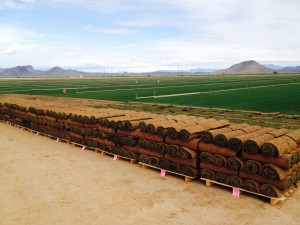Apr
Getting Your Lawn in Top Shape During Spring Transition
**Due to California and Arizona’s statewide shelter at home orders because of the coronavirus, West Coast Turf is carefully and responsibly continuing to operate using heightened hygiene and social/physical distancing rules to maintain the health and safety of our employees and customers.
We are monitoring available information and are able to continue to supply sod since it’s an agricultural product, and supply hardware stores, nurseries, and construction, which are listed as exempt from the order.
All orders must be prepaid on the phone or website. Orders will be delivered without any contact, and know that we appreciate and value our loyal customers.
Please be aware that this could change at any time if further clarification is given by either State. We are open and here to help you with your turfgrass needs.**
___________________________________
A lot of us have some extra time at home right now, and are spending more time out on our California and Arizona lawns.
There’s a renewed appreciation for nature and the outdoors. And, the sight of green grass and the smell of fresh cut grass has proven to be beneficial to our mental health and help curb anxiety–that’s ALWAYS welcome–especially now.
Taking care of your lawn can be productive, therapeutic, and something you can do alone, or with someone else safely and socially distant.
Let’s talk about some things you can do right now to make sure your lawn transitions properly this spring……
Spring Transition
As the temperatures begin to rise it’s a good time to look at your lawn program. Did you overseed your warm season lawn or allow it to bounce into dormancy (*jump to the bottom of the page for a dormant lawn)? Either way there are some important items to remember so you have a healthy, lush lawn all year long. It’s still a little early to see the full effects of transition. If you plan right your transition will be seamless.
Transition typically occurs in April and May, but being proactive now can speed up the process. For anyone that’s gone through a spring transition you’ve probably learned the worst mistake is to start too late.
Comments Off on Getting Your Lawn in Top Shape During Spring TransitionApr
Spring Transition for Your Arizona and California Sod
Spring Transition
As the temperatures begin to rise it’s a good time to look at your Arizona & California lawn program. Do you have an overseeded lawn? Or is your lawn starting to bounce out of dormancy (jump to the bottom of the page for a dormant lawn)? Either way there are some important items to remember so you have a healthy, lush lawn all year long. It’s still a little early to see the full effects of transition. If you plan right your transition will be seamless.
Transition typically occurs in April and May, but being proactive now can speed up the process. For anyone that’s gone through a spring transition you’ve probably learned the worst mistake is to start too late.
Here is a step by step process that can be implemented into everyone’s program over time. Some people fear putting down an overseeded lawn at this time of the year but there is no need to worry. The roots of the ryegrass actually help the grass knit into the ground quicker and as the temperatures warm up the ryegrass easily transitions out. I will note that you don’t want to buy sod with 3” ryegrass. But we keep our turf at ½” to ¾” at this time of the year so it makes for an ideal transition without any fuss.
1. Gradually lower you’re mowing heights to reduce the turf canopy. Warm season grasses are not shade tolerant and excess ryegrass provides shade. No need to scalp the lawn, just lower the height down and begin to thin out the grass.
2. Lightly verticut the lawn to open up the canopy and let sunlight into the grass below.
3. Be careful of fertilizer rates at this time of the year. Stick to slow release products such as Soil Burst 4-4-2, 11-52-0, 6-20-20, or 21-7-14. You want to put a pound of nitrogen per 1000 SF down when you make this fertilizer application. The first number on the bag is nitrogen and it is listed as a percentage. For example the 21-7-14 is 21% nitrogen. A typical fertilizer bag weighs 50 lbs so 21% of the 50 pounds is nitrogen. In other words you have 10.5 pounds of nitrogen in a 50 lb bag. Since the goal is apply one pound of nitrogen you would use the following formula:
1 pound of nitrogen / .21 (percentage of nitrogen on the bag) = 4.76 pounds of product per 1000 SF will yield 1 pound of nitrogen.
4. If you have standing water it is a great time to aerify so you can help air and water better infiltrate the soil.
5. Increase your mowing frequency to two times per week.
6. Gradually back off the water next month to stress out the ryegrass when soil temperatures reach 64 degrees (around mid-April). Turning off the water completely will stress out the warm season turf and ryegrass so this is not the optimal approach. Use 60% of your normal water rate.
7. When soil temperatures reach 64 degrees apply Soil Burst 4-4-2 at 15 pounds per 1000 SF to give the grass a jump start on the year. A second option to this is to use ammonium sulfate 21-0-0 at 5 pounds of product per/1000 SF.
8. Fertilize with 1-2 pounds of nitrogen per 1000 SF monthly over the summer. You can use any combination of the products I listed above as well as several others to help you achieve your goal of a perfect lawn. For a more accurate analysis on other nutrients you can send soil samples into a lab for results.
Once you’ve followed all of these steps you can set your irrigation to run 3 to 4 times per week for 20-30 minutes at a time. If you can’t water for 30 minutes without getting runoff it is okay to break it up into a cycle/soak.
Non-Overseeded Lawn
By now you’re probably tired of seeing the yellow/brown turf and want to give your Arizona & California lawn a jump start. While it’s still too cool outside to get your California or Arizona lawn growing, you can get it to green up. The enemy of a dormant lawn is the cool nighttime temperatures. A couple weeks ago we received some pretty good freezes which sent any green tissue in the lawn right back into dormancy. At this point we’re likely in the clear from a freeze. You can gradually begin to ramp up your water and fertilizer program.
Let’s start with how much water you need to put on your lawn. The soil temperature is still cool enough that watering 1-2x per week for 10-15 minutes is plenty. It’s good to keep the roots nice and moist and allow the plant to start to thrive. Overwatering right now has potential to cause disease in your lawn. When the daytime temperatures get into the 90’s you can increase to 2-3x times a week and slowly ramp up to 3-4x a week by May.
Bringing the grass out of dormancy can be accomplished several ways. I like to do so with products such as 11-52-0, 15-15-15, or Soil Burst 4-4-2. Putting down excessive nitrogen right now will not benefit your bermudagrass since it’s not warm enough to actively start growing. These products will help green up your lawn and slowly bring it back without a jolt of nutrients. Adding too much fertilizer could put the lawn in shock if we were to experience one additional cold snap over the next month. You don’t want the grass to use all of its reserves in the plant too early only to get shocked by some cold weather.
Be sure to check all of your sprinklers and spray patterns. There is a good chance some sprinklers broke and nozzles were damaged over the winter. These are very simple fixes and can be done for just a few dollars. Having the correct spray pattern and coverage can save you money all year long.
If you have any questions please let me know.
Until next time,
Jay
Comments Off on Spring Transition for Your Arizona and California SodMar
Spring is on the Horizon – Arizona & California Turf Prep Tips
- Keep an eye on the temperature. At the point that it gets warmer than 65º at night consistently, you know you are ready for your spring transition.
- At this point, you can start reducing your water usage to about 70% (or even 80%) of your normal usage. This is a process that helps support the bermudagrass or paspalum (as it begins to kill the ryegrass). Note: do not try to do any drastic methods for this, such as halting watering altogether or scalping your lawn. This not only kills the winter rye grass, but also the hibernating warm season grass.
- Now we want to allow more sunlight to reach your warm season grass. We can effectively do this by verticutting the grass, which will allow the grass to open up its canopy. That process then allows more sunlight to get to the warm season grass.
- Aeration is the next step and this process breaks up hard pockets of soil and increases water penetration as well as nutrient intake, among many other things that help the warm season grass.
- You will need to start lowering your mower settings while increasing your mowing intervals to twice weekly, making sure the height of the grass doesn’t exceed a half inch (or at the highest, ¾ inch). Bag your clippings when you’re done!
- Fertilize your warm season grass and increase your watering schedule. It should take about two weeks before you see the bermudagrass overtaking the ryegrass. Gradually, you’ll increase your watering to a typical summer watering schedule.
Sep
Winter Overseeding Your California and Arizona Sod Lawn
We often see overseeding your warm season California or Arizona sod lawn as a process that should be done in a weekend. For some this may be the most convenient way to prep but for others its okay to take a week or two to complete the process. Trying to knock it all out in one weekend can result in some really long days out in the heat. My suggestion is to slowly start the process now so in a couple weeks when the overseed window opens you’re ready to go and won’t be wasting your entire Saturday on the lawn. Remember that the ideal window is when nighttime temperatures are in the 60’s. We’re currently sitting in the high 70’s so I would expect a couple more weeks. To follow overseed instructions scroll to bottom of this blog.
Prepping for overseed is often a large ordeal, but starting the process gradually can eliminate a lot of headaches. I want to reiterate something I have said for the past few years. The height of the grass is not associated with a quality overseed. In other words, scalping the grass down to the dirt does not guarantee good results, but opening up the turf canopy does. The shorter you mow your lawn the tighter the leaf blades become making it harder to get the ryegrass seed into the plant. If the seed is lying on the surface it will be slow to germinate and much of the seed will be lost. The seed needs a base to grow out of, and getting inside the grass plant allows for perfect moisture, heat, and a solid growing medium. This is why it’s so important to have a good warm season grass base. If you have a new lawn or a weak summer lawn it can have a direct impact on your overseed. The seed will establish much faster inside a healthy grass stand than it will on bare dirt.
Comments Off on Winter Overseeding Your California and Arizona Sod LawnMar
Seashore Paspaulum and Spring Transition for Your Warm Season Lawn
Arizona Diamondbacks
As many of you know BOBSod has been the turf of choice for the Diamondbacks since its conception in 1998, but this year we made a change. The Diamondbacks grounds crew experimented with a few different varieties over the last year and they decided to make the change to the environmentally friendly Platinum TE seashore paspalum. While the BOBSod is still performing at an extremely high level, a shift was made to go with a grass that could be installed without overseed in early March. For those not familiar with paspalum one of its best attributes is its shorter dormancy period. Paspalum can handle temperatures that drop into the 40’s at night before losing color while bermudagrasses will start to lose color in the 50’s. This often leads to a 3+ weeks longer season in the fall and can often green up a few weeks earlier in the spring.
Having the roof over Chase Field provides a lot shade during the spring transition and can really extend the life of the ryegrass. As you probably have learned from your bermudagrass lawns over the years shade will take out your grass over time. Since the ryegrass can live longer inside the stadium, it makes for a longer transition. With this in mind the groundskeeper decided to make the choice to use a non overseeded grass and avoid any transition.
Comments Off on Seashore Paspaulum and Spring Transition for Your Warm Season Lawn
Jan
Weeds and Your Arizona and California Lawns.
We haven’t had a very wet winter but with the recent rains we’re going to start to see the emergence of some winter annual weeds. The good news is the weeds that are starting to emerge are easy to control.
There are some types such as annual bluegrass, crabgrass, and nutsedge that are a little more complicated but timing pre-emergent herbicide applications can save you a lot of headaches with weed control. In this blog I will go over various weeds and some ways to control them as well as discuss herbicide timing. Weed control management is a function of several different factors but some of the things you can do to keep your lawn healthy are maintain the proper mowing height, not overwatering, fertilize monthly, and aerate the turf when the soil becomes compacted. These items right here can be the difference between weeds slowly emerging in your lawn and taking over your lawn. A healthy lawn will push out weeds and keep them to a minimum. If you have very few weeds emerge during the year chemical applications are usually unnecessary and weeds can be pulled by hand as they appear.
Comments Off on Weeds and Your Arizona and California Lawns.Nov
You Have Overseeded Your California or Arizona Sod Lawn–Now What? And….Even if You Haven’t.
By now most of you who are going to overseed have either begun the process or have had your seed down for a few weeks. Today I want to discuss what to do now that you have the ryegrass growing and cooler temperatures are on the horizon.
Getting your ryegrass up and growing is obviously the first step to a successful winter lawn but what about maintenance? How can you make sure your ryegrass is strong going into the winter and you will have a full stand of ryegrass once the temperatures begin to drop into the 40’s at night? There are several key items associated with a strong winter lawn but early preparation should be high on your list.
Comments Off on You Have Overseeded Your California or Arizona Sod Lawn–Now What? And….Even if You Haven’t.Sep
FAQ About Fall Overseeding of Your Warm Season Grasses
A couple weeks ago I put out a post on overseeding and now that we’re through September it’s time to get the process started. Click here for the previous post on overseeding for full instructions. In today’s blog I wanted to pass along some of the most frequently asked questions during this time of the year.
When is the best time to start overseeding?
Ideally overseeding should be done when nighttime temperatures are consistently in the 60’s. Typically this will be the month of October. Obviously there will be some spikes and lower than normal temperatures during this period but anytime during October is good.
How low do I need to scalp the grass prior to seeding?
The height of the grass isn’t as important as opening the turf canopy. The shorter you mow the grass, the tighter the turf canopy will be which will result in the need to verticut more aggressively. I recommend not going lower than ½”. There is no need to take the lawn to the dirt or you will cause long term problems to the grass plant. Read the rest of this entry »
Sep
California and Arizona Sod Tips: It’s ALMOST Time to Overseed Your Lawn!
With the recent heavy rains and slightly cooler temperatures no doubt people are thinking about overseeding their California and Arizona lawns. While the calendar says September 18th and you will surely see people overseeding, I suggest you wait a few weeks. Follow my California and Arizona sod tips for a beautiful lawn. Overseeding does not need to be a one day process. You can begin the process a little early. Then, when temperatures are in the 60’s at night, you will just need to give your lawn one last haircut, drop the seed and begin watering.
Preparing to Overseed
Prepping for overseed is often a large ordeal. By starting the process gradually you can eliminate the headaches associated with trying to do it all in one afternoon. I want to reiterate something I have been saying for the past few years. The height of the grass is not associated with a quality overseed. In other words scalping the grass down to the dirt does not guarantee good results. Opening up the turf canopy does.
The shorter you mow your lawn the tighter the leaf blades become. This makes it harder to get the ryegrass seed into the plant. If the seed is lying on the surface it will be slow to germinate and much of the seed will be lost. The seed needs a base to grow out of. Getting inside the grass plant allows for perfect moisture, heat, and a solid growing medium. By looking at my last statement you can now understand why I say without a good warm season grass base (used on popular California and Arizona lawns) you will most likely have a poor ryegrass season. The seed will establish much faster inside a healthy grass stand than it will on bare dirt.
Comments Off on California and Arizona Sod Tips: It’s ALMOST Time to Overseed Your Lawn!Aug
Summer Tips for Your Sod Lawn in Arizona and California
Summer is wrapping up, the kids are heading back to school, and I’m sure you’re ready to come out of hibernation. While the summer heat is far from over in Arizona and California, it’s starting to become tolerable outside. With the slightly cooler mornings it’s time to get back outside and get your lawn ready for fall. Most people start thinking about overseeding their California and Arizona sod in September, but ideally you wouldn’t start the process until October when nighttime temperatures get into the 60’s. Between now and then there are some important steps you need to do to get your lawn ready and to save some headaches down the road.
Between May and September you probably noticed your lawn has grown at twice the rate it does during the winter months. Warm season grasses love the warm, wet weather. Most people thought the hot weather would keep the grass from growing well, but remember warm season grasses optimal growing temperatures are between 90-105 degrees. During this season any of your weaker areas should have filled in with the warm season grasses runners. These spots can be slow to fill in during the dry, hot days but as soon as the humidity kicks in the grass really takes off. If you still have large open spots I would suggest picking up a few rolls of sod and patching them prior to overseed. You don’t want to seed directly into the soil.
Comments Off on Summer Tips for Your Sod Lawn in Arizona and California






